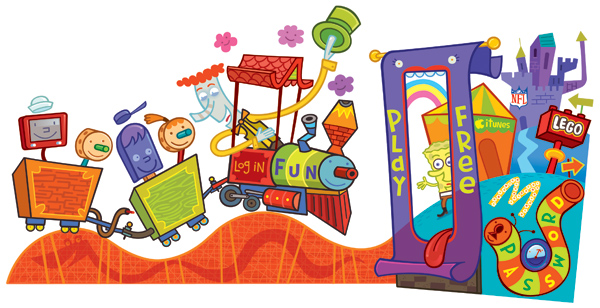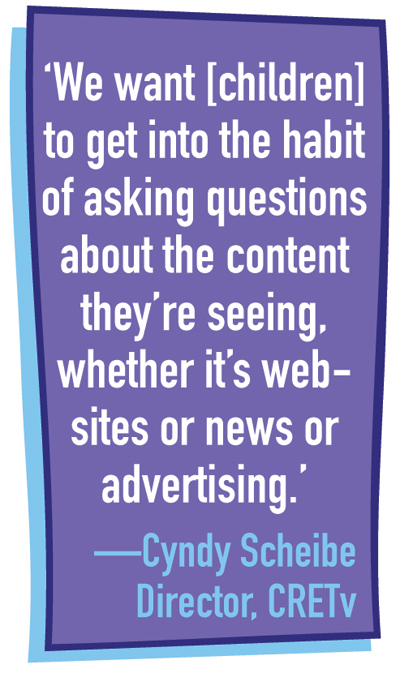
Illustration by Jim Paillot.
It’s oh so easy to overlook what’s happening online—and if librarians, educators, and parents don’t notice it, why on Earth should kids?
What’s the mysterious it I’m referring to? Quite simply, every day young people are being bombarded by subtly manipulative forms of marketing on their favorite websites. Hang on a minute, you may be thinking, my students only visit sites that are safe, filtered, and free—what’s not to like?
Well, the problem is that more often than not these free kid-friendly sites are also extremely brand-friendly and advertising-friendly. Take, for instance, “advergames,” popular digital destinations for members of Gen Z. As the name suggests, an advergame is a hybrid of two different types of media, and it’s that dual nature that makes advergames (which often include harmless diversions like mazes, memory challenges, puzzles, and cute racing circuits) so sneaky: kids recognize the “game” part readily enough. The “adver” part? Not so much.
The goal of media literacy is, in part, to help students perceive those distinctions—and that’s where librarians and other educators can play a vital role. Advergames and their new media equivalents, such as Web and mobile ads, are far subtler than a massive roadside billboard or a banner draped across a classroom chalkboard that proclaims, “Sponsored by General Motors.” In fact, Web marketing often represents a kind of sleight-of-hand that’s connected to a much more scrutinized advertising platform: TV.
According to Emma Alder, who studied TV ads in children’s and teen programming at the Center for Research on the Effects of Television (CRETv) in 2008 and 2009, roughly 56 percent of all on-air commercials encourage kids to visit a specific website. That’s a substantial percentage, but it’s not overwhelming, right? But just take a look at the data presented in “Children and Advertising: Content, Comprehension, and Consequences,” an article which appeared in Dorothy G. Singer and Jerome L. Singer’s Handbook of Children and the Media (Sage, 2011). In the report, the University of Arizona’s Dale Kunkel (who was part of the American Psychological Association’s influential Task Force on Advertising and Children) and Jessica Castonguay cite research that shows that 87 percent of “children’s most popular websites [include] some form of advertising.” Their report also draws on additional research from the past decade that demonstrates that these “websites not only contain traditional billboard or banner-style advertising but also include advergames that engage children in entertaining activities while immersing them in a product-related environment” and that “advergames [are] included in 63 percent of children’s websites.”
Aye, and there’s the rub. Websites associated with children’s television, including the Cartoon Network, Nickelodeon, and even PBS Kids, offer advergames as one of their main draws. No, these games aren’t hawking junk food or toys that promote gender stereotypes (although on a recent visit to the Disney Channel’s home page, I was treated to a Barbie ad that automatically began playing as soon as I arrived). Instead, these activities feature a form of advertising that’s akin to TV’s on-air promo in which the “product” being promoted is simply television programming itself. This blurring of online content’s entertainment and commercial functions is troubling, especially since kids may not be aware of the latter. Like others who study this phenomenon, CRETv’s director, Cyndy Scheibe, calls it “advertising bleed”— in which the line between commercial and noncommercial content has been muddied, perhaps intentionally.
Does the attempt to create stronger brand loyalty for shows like SpongeBob really constitute a public health menace that must be stamped out immediately? What harm can possibly come of it? Here’s how Erin McNeill, the founder of the website “Marketing, Media and Childhood,” sees it: “Among the philosophical reasons why the overwhelming amount of advertising that is directed at children today is a particular problem is that it sets them up early with materialistic values that can lead to a lifetime of unhappiness.”
Does that sound too abstract, not sufficiently hard-nosed for you? If so, McNeill is quick to point out that, in the United States at least, there’s a prohibition against “unfair and deceptive acts or practices in commerce,” which the Federal Trade Commission is charged with enforcing. Of course, this begs the question of whether advergames are always deceptive. When they’re aimed at children, I personally feel that they are, but don’t just take my word for it: according to the American Academy of Pediatrics, directing any form of advertising at kids younger than eight years old is inherently deceptive and, therefore, exploitative. Why? Because children of that age simply lack the analytical tools to react responsibly to those ads. And as far as I’m concerned, kids older than that don’t necessarily have those tools either, by virtue of their age alone—indeed, it’s up to us to ensure that they do.
 It may seem that the best thing for librarians to do is simply to ban the presence of most websites that target kids with their ads. But the concept of censoring content isn’t one that fans of libraries and free speech are fond of, and with good reason. Moreover, for educators there’s also a key media literacy lesson to be learned here. As Scheibe, coauthor of The Teacher’s Guide to Media Literacy: Critical Thinking in a Multimedia World (Corwin, 2011), puts it, “I think that trying to steer children—especially younger children—away from websites that contain commercial messages is one way to go, but if we only do that, there is a missed opportunity for the teachable moment. We want them to get into the habit of asking questions about the content they’re seeing, whether it’s websites or news or advertising.”
It may seem that the best thing for librarians to do is simply to ban the presence of most websites that target kids with their ads. But the concept of censoring content isn’t one that fans of libraries and free speech are fond of, and with good reason. Moreover, for educators there’s also a key media literacy lesson to be learned here. As Scheibe, coauthor of The Teacher’s Guide to Media Literacy: Critical Thinking in a Multimedia World (Corwin, 2011), puts it, “I think that trying to steer children—especially younger children—away from websites that contain commercial messages is one way to go, but if we only do that, there is a missed opportunity for the teachable moment. We want them to get into the habit of asking questions about the content they’re seeing, whether it’s websites or news or advertising.”
How can we help kids become more media literate? Well, as it turns out, there’s plenty we can do. Here are some teaching strategies that can be used with kids in a wide range of grades:
• Start by asking students some basic questions, including, “Why might these sites provide free games when others require payment?” I’ve asked fourth and fifth graders that question, and it’s sparked some great “Aha!” moments—especially when kids connect the concept to free TV programs and how, in essence, the viewers are the “products” whose eyeballs are “sold” to the advertisers.
• Help kids decode individual Web pages and identify popular advertising practices. For example, point out that banner ads typically appear at the top of a page and smaller ads are often in the margins.
• Teach struggling readers how to spot crucial “ad breaks.” Since the word “advertisement” may appear perpendicular to the main text, it may be difficult for some students to notice it.
• Point out how games commonly include distinctive logos that are designed to make a lasting impression on viewers. Patricia A. Russac and Mercer Hall, a library director and classroom teacher, respectively, at New York’s Buckley Country Day School, use this strategy as early as second grade, when they begin teaching kids about branding and logo design. “We use cereal boxes which hang in the library to identify the different aspects used to sell to adults vs. children,” says Russac. “The kids love it and really learn to decode them, especially when they can compare three different brands of the same product such as Cheerios or Chex. They learn to look at color, cartoon characters, fonts, placement, and nutrition. They notice things such as the letters in ‘Go Lean’ cereal get thinner as it’s spelled.”
• Encourage self-reflection by asking students how frequent exposure to TV shows’ logos, characters, and other aspects of their “brand” may eventually lead to a preference for them.
• Explain that sneak previews and exclusive video clips, regardless of how much fun or informative they might be, are actually ads, much like movie trailers and the behind-the-scenes “news” segments that one sees in theaters.
• Here’s a great one, suggested by Scheibe that turns the notion of games on its head: “We can empower children—rather than simply protect them—by playing a game of ‘guess what they’re selling?’ and teaching them to spot ads and product placements in a wide range of content,” she says.
At the beginning of the school year, Jane Koestler, a teacher at South Hill Elementary School, in Ithaca, NY, teaches children about product placement in the broader world—and in school. One particularly instructive moment occurred when she was screening a film about puberty and noticed that the makers of Always sanitary napkins sponsored it. When the inevitable product placement arrived, Koestler focused the discussion on media literacy, rather than on the lesson’s initial curricular purpose.
• Explain how free goodies such as desktop “wallpapers” also constitute a form of promotion. Ask your kids, “Who’s really getting something for free here—you or the company that now has a free ad via your property?”
• Encourage critical thinking about online tools that are used for media production or remixing. While these resources can provide important learning experiences, point out that the elements being remixed or repurposed usually involve proprietary characters, rather than students’ own creations.
• Most importantly, encourage kids to monitor their own online usage patterns. How, for example, did they find out about a particular website, and what are its subtle influencers that prompt them to watch yet more television… in effect forging a symbiotic relationship between the two media?
To be sure, research findings are still emerging on the effects of online ads and the pedagogical approaches that might best address them. Still, we now know that the goal is, yes, to have kids enjoy all that engaging free online content, but in a way that both exercises and strengthens their media and information literacies.
So, yes, it’s easy not to do anything about all the e-marketing that’s aimed at kids—but it’s also not that difficult to help students develop the critical thinking skills that they desperately need.
 Peter Gutiérrez (fiifgutierrez@gmail.com) explores the world of pop culture, media literacy, and critical thinking on his SLJ blog, “Connect the Pop.”
Peter Gutiérrez (fiifgutierrez@gmail.com) explores the world of pop culture, media literacy, and critical thinking on his SLJ blog, “Connect the Pop.”

